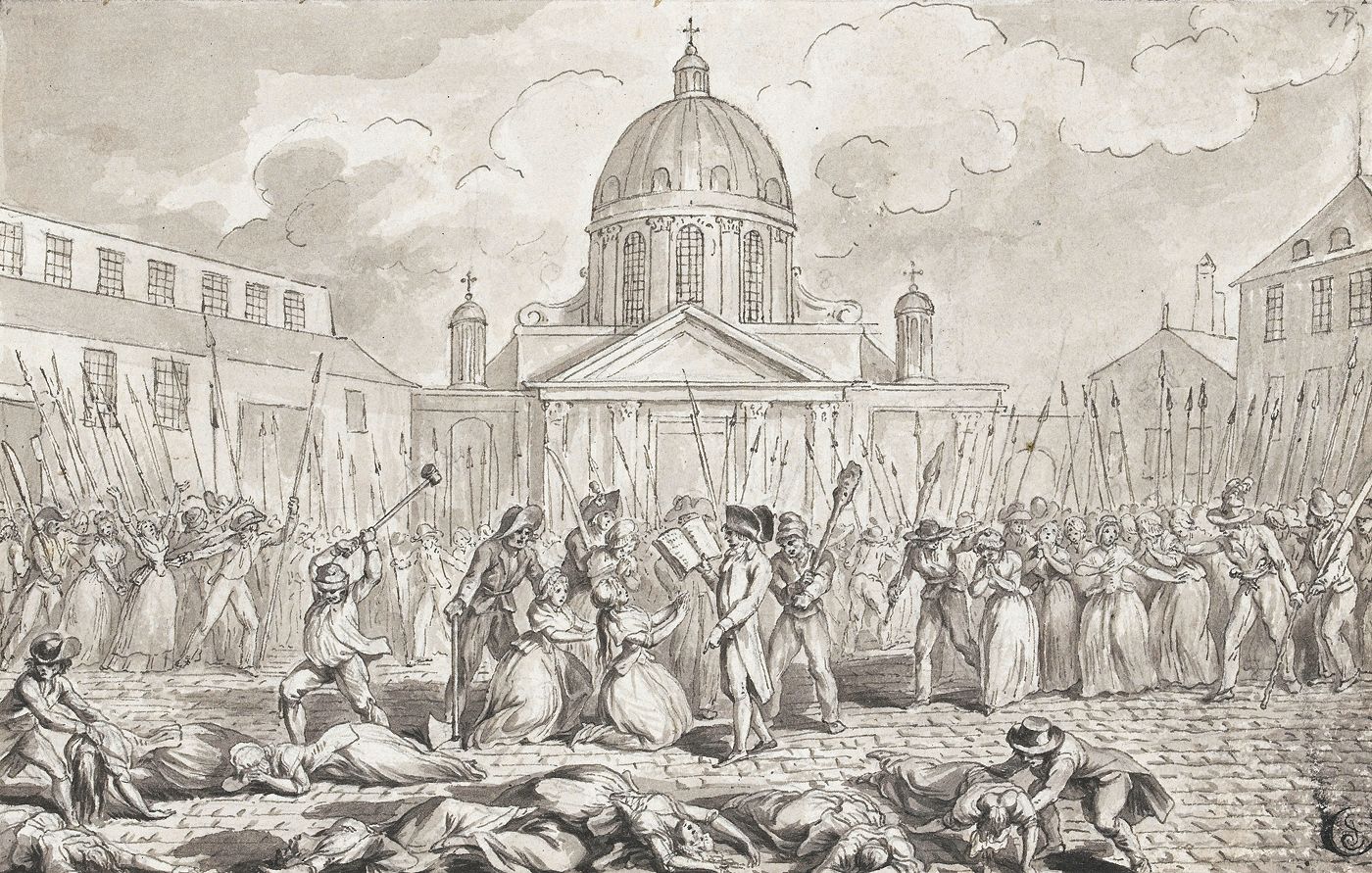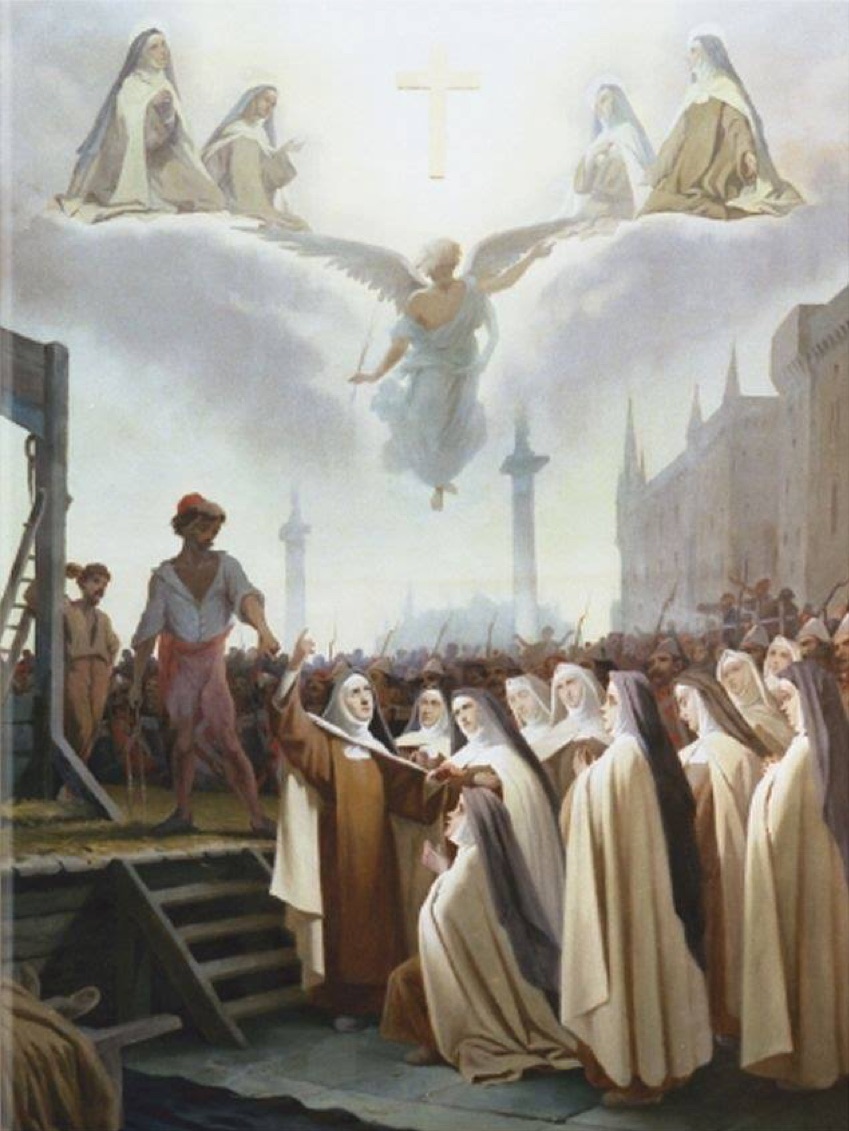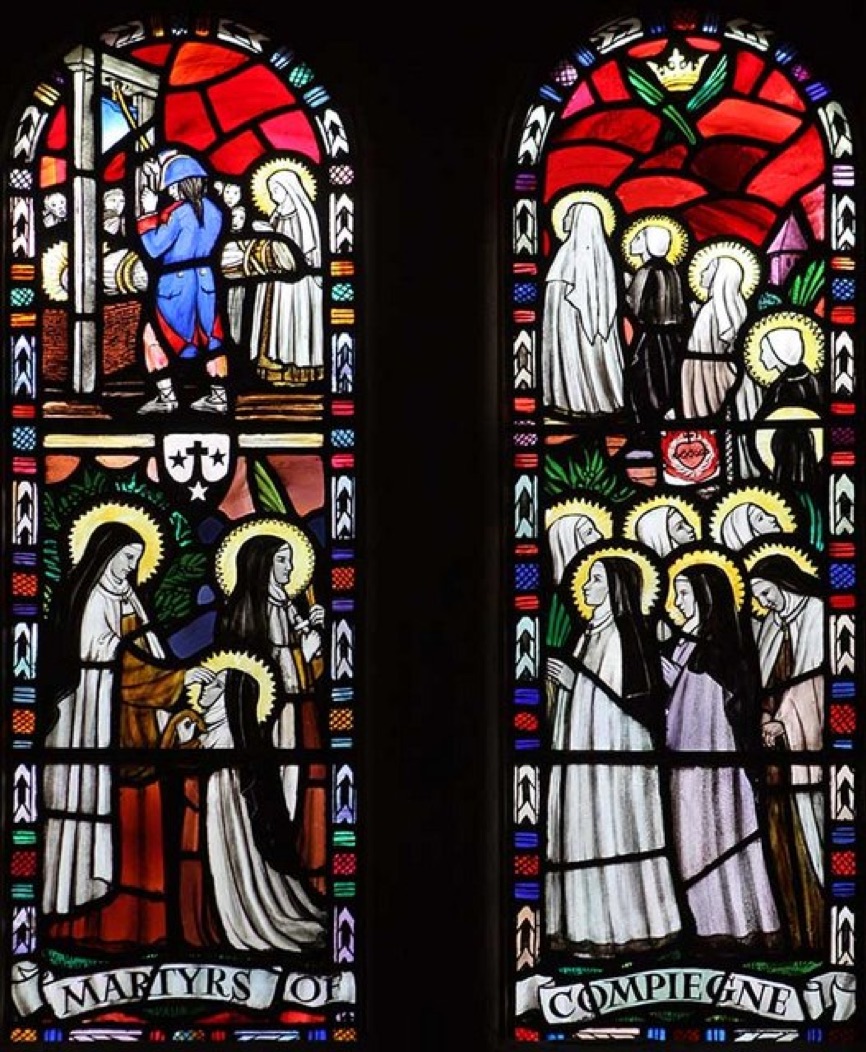Historical Context
History of Dialogues
By Erin Bailey, Mishelle Cipriani, and Jana Conrad
Section 1- Historical Context
“Terror is nothing other than prompt, severe, inflexible justice.”
– Robespierre “The Incorruptible”
The French Revolution was instigated in part by the poor and starving masses, but was also fueled by the Enlightenment Movement: an intellectual movement that celebrated reason over religion, science over faith, and freedom over monarchy. After fighting for a people-represented government, extremists suspended their democratic achievements to focus on social matters and destroying internal enemies. This new effort started with the formation of the Committee of Public Safety: a dictatorial group run by Robespierre whose goal was to feed and educate the poor through taxing the rich and controlling the price of commodities as well as to destroy their enemies (the aristocracy and the clergy).[1] The latter goal was accomplished by setting up “surveillance committees” of average citizens who could accuse anyone of treason for which the accused would be imprisoned indefinitely. If they didn’t die in prison, they would face a non-public trial without legal assistance and receive either acquittal or execution—there was nothing in between. During this “Reign of Terror” an estimated 18,000-40,000 people were executed, many by guillotine. Many more, 200,000 – 300,000 were detained, and many of those died in prison from starvation or disease.[2]
During the Revolution, the Roman Catholic Church took a strong position against the revolutionaries requiring clergy to take an oath of loyalty to the nation, though many did not take the oath. The insurrection in Vendée in 1793 against the revolutionaries led by former nobles and priests and supported by Great Britain further fueled the animosity towards The Church and strengthened the anti-Christian movement.[3] In the end, Robespierre was himself executed by guillotine on July 28, 1794; one day after the end of the “Reign of Terror.”

http://cdn.history.com/sites/2/2013/12/reign-of-terror-hero-H.jpeg
Section 2- Story
In 1789 following the storming of the Bastille, the newly-formed “government” of the people confiscated all church property and sent out a decree forbidding religious vows. The Carmelite nuns continued to live at their convent and journal accounts[4] document a beautiful dream that Madame Lidoine shared with her sisters of being clothed in white and “following the Lamb.” In August of 1792 an organized mob took the Tuileries Palace, and soon afterward, the September Massacres shook the nation. Many prisons were emptied of those waiting for trial or those who had been taken for “crimes” against the state. Many Christian martyrs were killed, along with anyone who had sworn allegiance to the king. On September 14, 1792, after the Feast of the Exaltation of the Cross, the Carmelites were expelled from their monastery, along with all others in religious convents and monasteries.
The exact date is unknown, but some time before November 27 of that year, Madame Lidoine proposed the idea of a community act of holocaust to save France and the church. This idea was not immediately embraced by all members of the community; in fact, some were quite opposed to the idea at first. But it appears that quickly all united in the idea of self-sacrifice for the good of their country and religious beliefs. On June 22, 1794, the sixteen Carmelite nuns were arrested and events were set in motion that would bring these nuns to the scaffold within a short period of time.

Image of September Massacre taken from https://en.wikipedia.org/wiki/September_Massacres
Section 3- Day of Execution
When the Carmelite nuns were ordered to leave Compiegne on July 12, they were in the middle of washing their civilian garments by the order of the mayor. He then received the order to transfer them to Paris, having forgotten they were in the middle of doing their laundry, he had no choice but to allow them to wear their forbidden habits on their journey.[5] These habits were their choir mantles, which were white, just as the dream Madame Lidoine had discovered two years prior. On the eve of the Carmelite execution, the civilian clothing the Carmelites left soaking in Compiegne were given to the English Benedictine nuns imprisoned to wear instead of their habits. This form of oppression by the government actually became a source of encouragement in the faith. Their clothing was venerated by the Benedictines as relics after the martyrdom. The eve of the Carmelite execution was also the last time they would celebrate their patronal Feast of Our Lady of Mount Carmel.[6]
At the Place de la Nation (Place of the Toppled Throne), not a single voice from the crowd spoke as the Carmelite nuns ascended individually to the guillotine. The nuns sang together the Veni Creator Spiritus before the executions began. They renewed their vows, received a blessing from the Prioress, and kissed a little clay statue of the Virgin and her Child as each one ascended singing together Psalm 117, which was sung at the founding of their convent. Sr Constance was the first to be executed asking the prioress, Madame Lidoine, for “Permission to die” to which she responded “Go, my daughter.” The prioress followed her daughters and was the last to be executed.[7]
Section 4- Impact
The Carmelite nuns had hoped through their vows of martyrdom to bring peace to France. The Revolution had set in motion a ten-day calendar as a means of eliminating the seven-day calendar, which holds a lot of religious purpose in Christianity.[8] After the Carmelite sacrifice on July 17, 1794, only one ten-day week passed when the Great Terror ceased on July 27. Through their sacrifice, like the words of one of the nuns before the guillotine, “Only too happy, O my God, if this little sacrifice can reduce the number of victims!” was the Carmelite’s wish for peace fulfilled even through the calendar of the Revolutionaries.[9] Though their relics were never obtained, having been thrown in a common grave, the Carmelite nuns were beatified on May 27, 1906 by Pope St. Pius X by their miracles, such as curing Sister Clare of St. Joseph of cancer.[10] For more information about the sixteen women who were executed, see John Wainewright’s “The Sixteen Blessed Teresian Martyrs of Compiègne.”[11]

Carmelite martyrs of Compiègne

Stained glass window in the Church of Our Lady of Mount Carmel, Norfolk, England
[1] Maximilien Robespierre | Biography, Facts, & Execution. (2019). Retrieved from https://www.britannica.com/biography/Maximilien-Robespierre
[2] Reign of Terror | History, Significance, & Facts. (2019). Retrieved from https://www.britannica.com/event/Reign-of-Terror
[3] Dechristianisation during the Reign of Terror (1793-1794) - Musée protestant. (2019). Retrieved from https://www.museeprotestant.org/en/notice/dechristianisation-during-the-reign-of-terror-1793-1794/
[4] Details in this section are summarized primarily from the excellent research of William Bush.
Bush, William. 1995. “The Historical Parisian Martyrdom: July 17, 1794.” Renascence 48(1): 61-82.
[5] Bush, William. 1995. “The Historical Parisian Martyrdom: July 17, 1794.” Renascence 48 (1): 74.
[6] Bush, William. "The Martyrdom of the Sixteen Carmelites of Compiègne: A Christian Crowning of the Philosophers' Century." Logos: A Journal of Catholic Thought and Culture 2, no. 1 (1999): 214.
[7] Bush, William. 1995. “The Historical Parisian Martyrdom: July 17, 1794.” Renascence 48 (1): 77-79.
[8] Bush, William. 1995. “The Historical Parisian Martyrdom: July 17, 1794.” Renascence 48 (1): 71.
[9] Bush, William. "The Martyrdom of the Sixteen Carmelites of Compiègne: A Christian Crowning of the Philosophers' Century." Logos: A Journal of Catholic Thought and Culture 2, no. 1 (1999): 203-204.
[10] Wainewright, John. "The Sixteen Blessed Teresian Martyrs of Compiègne." The Catholic Encyclopedia. Vol. 14. New York: Robert Appleton Company, 1912. 4 Apr. 2019 <http://www.newadvent.org/cathen/14517a.htm>
[11] Ibid.
